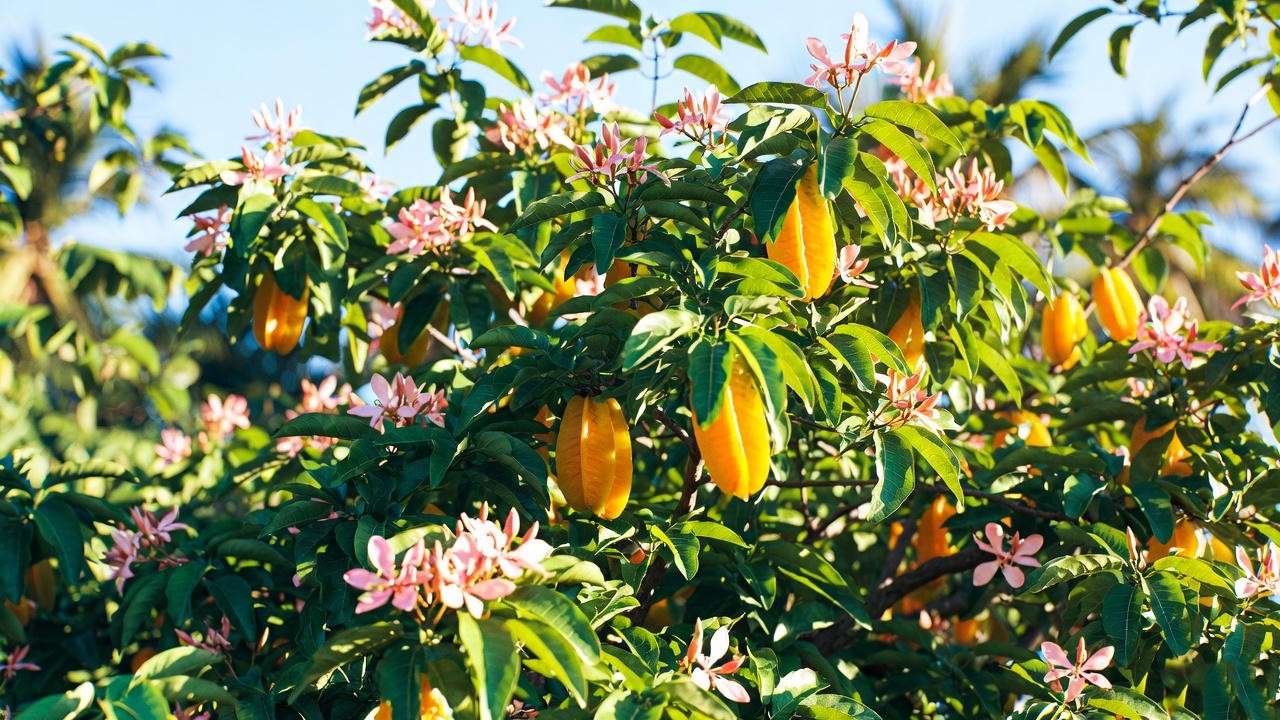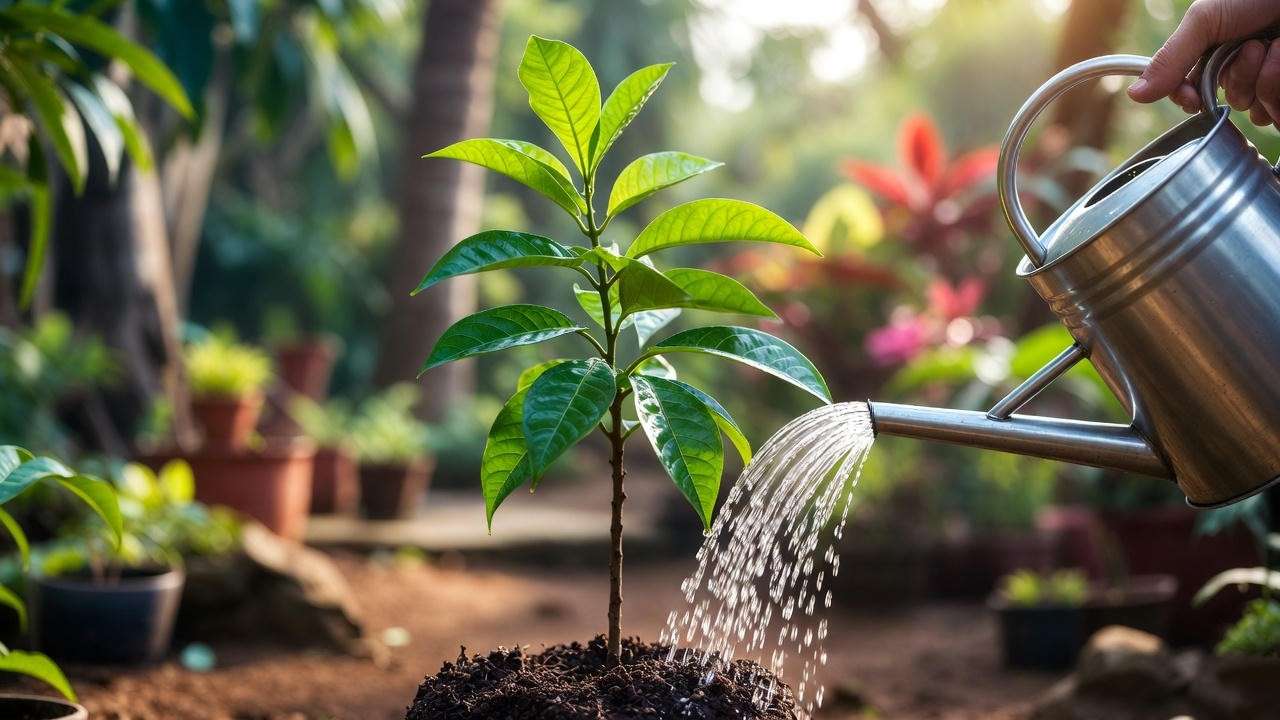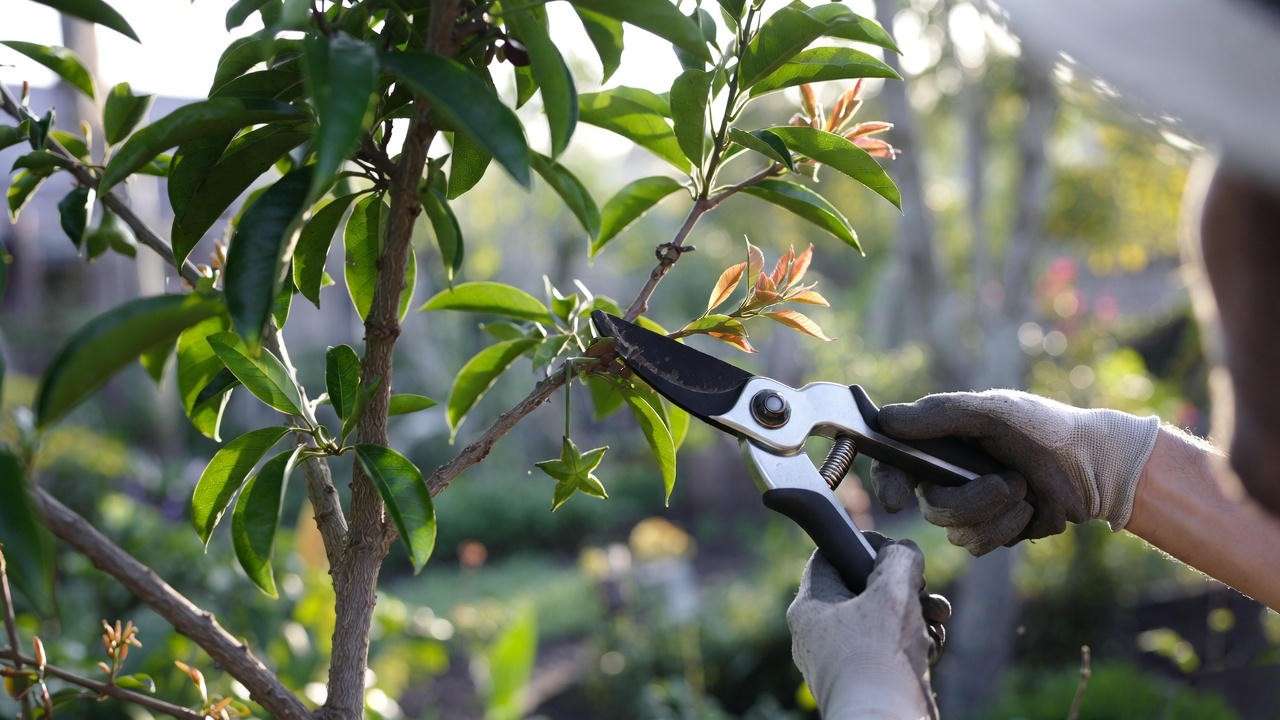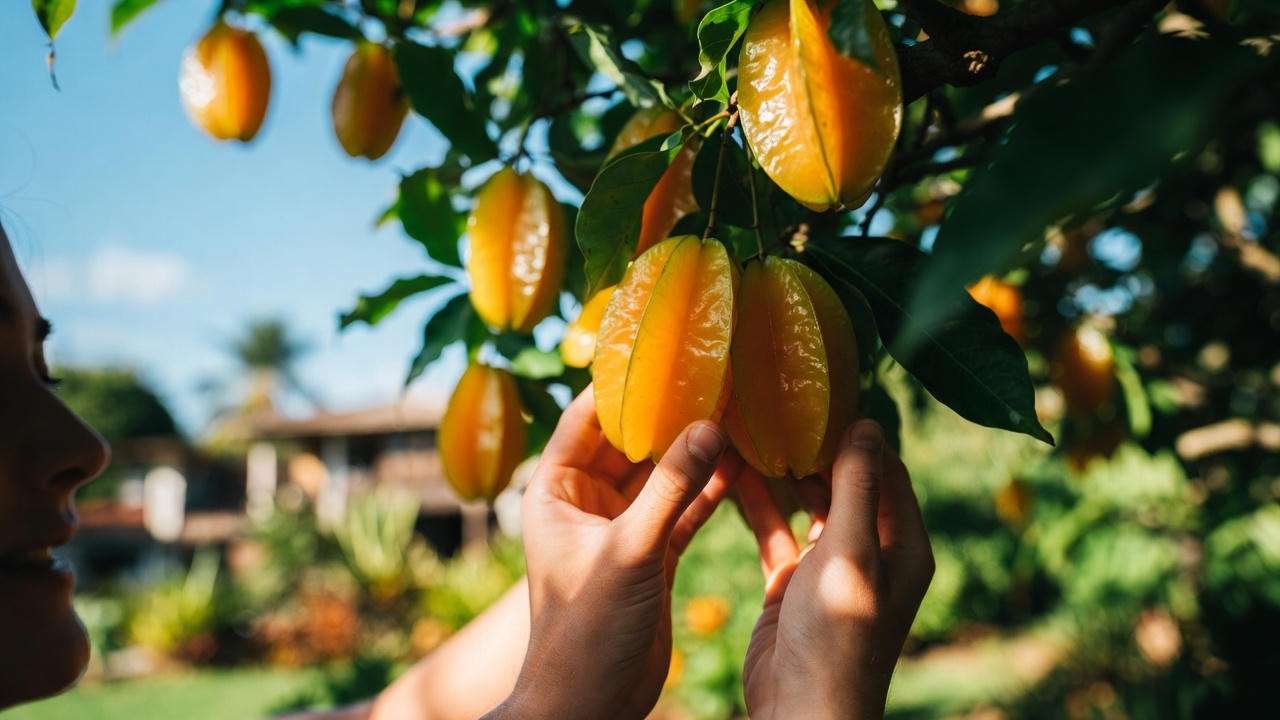Picture this: you step into your backyard, pluck a radiant, star-shaped fruit from your very own tree, and savor its sweet-tart juiciness. Growing star fruit plants (Averrhoa carambola) can turn this vision into reality, transforming your garden into a tropical paradise. But these exotic trees require specific care to thrive and produce abundant, flavorful fruit. Whether you’re a beginner gardener or a seasoned plant enthusiast, this guide delivers seven expert tips to help you grow vibrant, fruit-filled star fruit trees at home. Drawing on horticultural research and real-world experience, we’ll address common challenges and empower you to cultivate a flourishing carambola tree. Let’s dive into the world of star fruit and unlock the secrets to success! 🌴
Why Grow Star Fruit Plants? The Appeal of Carambola Trees 🍋
Unique Benefits of Star Fruit Plants
Star fruit plants are a standout choice for any garden. Their glossy, evergreen foliage and delicate pink flowers add ornamental beauty, while their star-shaped fruits steal the show with their vibrant yellow-orange hue. Beyond aesthetics, star fruit is packed with vitamin C, antioxidants, and fiber, making it a healthy addition to smoothies, salads, or garnishes. Its versatility shines in culinary creations, from refreshing juices to eye-catching dessert toppings. Plus, star fruit plants are well-suited for warm climates (USDA zones 9–11) and can thrive in containers, making them accessible for urban gardeners with limited space.

Environmental and Personal Rewards
Growing star fruit plants is a win for both you and the planet. Homegrown fruit reduces your carbon footprint by cutting reliance on store-bought produce, often shipped from afar. The joy of nurturing a tree from seedling to harvest is unmatched, offering a sense of accomplishment and connection to nature. Take it from Sarah, a Florida gardener who shared, “My star fruit tree started producing in just two years, and now my family enjoys fresh fruit all season!” This rewarding experience is within your reach with the right care. 🌿
SEO Keywords: Benefits of growing star fruit, carambola tree advantages, tropical fruit gardening.
Understanding Star Fruit Plants: A Quick Overview 🌴
Botanical Background
Star fruit plants, scientifically known as Averrhoa carambola, are native to Southeast Asia but have found a home in tropical and subtropical regions worldwide. These small evergreen trees or shrubs typically grow 20–30 feet tall in ideal conditions, though dwarf varieties stay more compact. They thrive in warm climates, particularly USDA zones 9–11, where temperatures rarely dip below 40°F (4°C). Their lush foliage and prolific fruiting make them a favorite among tropical fruit growers.
Varieties to Consider
Choosing the right cultivar is key to success. Popular varieties include:
- ‘Arkin’: Known for its sweet, juicy fruit, ideal for eating fresh.
- ‘Fwang Tung’: Offers a tart flavor, perfect for cooking or juicing.
- ‘Kari’: A dwarf variety suited for containers, great for small spaces. Each cultivar has unique traits, so select one based on your climate, space, and taste preferences. For example, ‘Arkin’ is a top choice for Florida gardeners due to its reliability and flavor.
Expert Insight: According to the University of Florida’s Institute of Food and Agricultural Sciences (IFAS), selecting a grafted tree rather than a seed-grown one can reduce fruiting time by several years, ensuring quicker harvests.
SEO Keywords: Types of star fruit trees, best star fruit varieties, carambola cultivars for home gardens.
Tip 1: Choose the Perfect Location for Your Star Fruit Plant ☀️
Sunlight Requirements
Star fruit plants crave sunlight. To produce vibrant foliage and abundant fruit, they need 6–8 hours of direct sun daily. Assess your garden by observing light patterns throughout the day. A south-facing spot is ideal in most regions, as it maximizes exposure. If you’re growing in a marginal climate, position the tree near a reflective surface, like a white wall, to amplify sunlight.
Climate and Temperature Needs
These tropical beauties thrive in temperatures between 68–85°F (20–29°C). They’re sensitive to frost, so if you’re in a cooler area (e.g., USDA zone 9), be prepared to protect your tree during winter. Use frost cloths or bring potted trees indoors when temperatures drop below 40°F. In consistently warm climates, like Hawaii or South Florida, star fruit plants flourish year-round with minimal intervention.
Container vs. Ground Planting
Star fruit plants adapt well to both in-ground and container planting:
- In-Ground: Best for spacious gardens with well-draining soil. Ensure the site allows for the tree’s mature size (up to 30 feet).
- Container: Ideal for patios or urban spaces. Choose a pot at least 18–24 inches wide with drainage holes. Dwarf varieties like ‘Kari’ are perfect for pots. For example, Maria, an urban gardener in Miami, grew a thriving ‘Kari’ tree on her balcony, harvesting 20 fruits in its second year. Containers also allow you to move the plant to optimize sunlight or protect it from cold.
SEO Keywords: Best location for star fruit plants, growing star fruit in pots, carambola tree sunlight needs.
Tip 2: Master Soil and Drainage for Healthy Roots 🌍
Ideal Soil Composition
Healthy roots are the foundation of a thriving star fruit plant. These trees prefer slightly acidic soil with a pH of 5.5–6.5. A mix of loamy soil, compost, and peat moss works well to provide nutrients and aeration. If your soil is too alkaline, amend it with elemental sulfur to lower the pH. Test your soil’s pH with a home kit for accuracy.
Avoiding Waterlogging
Poor drainage is a common killer of star fruit plants. Their roots are prone to rot if left in soggy conditions. To check drainage, dig a 12-inch hole, fill it with water, and observe how quickly it drains. If it takes longer than an hour, improve drainage by adding sand or organic matter. For container plants, ensure pots have ample drainage holes and use a well-draining potting mix.
Expert Tip: The Tropical Fruit Growers of South Florida recommend raised beds for in-ground star fruit plants in areas with heavy clay soils to enhance drainage.
SEO Keywords: Star fruit soil requirements, how to prepare soil for carambola, carambola tree drainage tips.
Tip 3: Watering Wisely for Vibrant Growth 💧
Watering Schedule
Proper watering is critical for star fruit plants, especially during their establishment phase. Young trees need consistent moisture—water every 2–3 days, keeping the soil evenly moist but not waterlogged. Mature trees are more drought-tolerant but benefit from deep watering every 5–7 days, adjusted for rainfall. In dry climates, increase frequency during hot summer months.
Signs of Over- or Under-Watering
Watch for these warning signs:
- Overwatering: Yellowing leaves, wilting despite wet soil, or fruit drop.
- Underwatering: Drooping leaves, dry soil, or stunted growth. A moisture meter can help you gauge soil dampness accurately. For example, if the top 2 inches of soil feel dry, it’s time to water.
Practical Tool: Invest in a simple moisture meter (available for $10–20 online) to take the guesswork out of watering.
SEO Keywords: How to water star fruit plants, star fruit tree care mistakes, carambola watering schedule.

Tip 4: Fertilizing for Maximum Fruit Production 🍎
Nutrient Needs
Star fruit plants are heavy feeders, requiring regular fertilization to support growth and fruiting. Use a balanced fertilizer with an NPK ratio of 6-6-6 or 8-3-9, supplemented with micronutrients like zinc and iron, which are critical for tropical fruit trees. Apply fertilizer every 6–8 weeks during the growing season (spring through early fall). Reduce feeding in winter when growth slows.
Organic vs. Synthetic Options
- Organic: Compost, fish emulsion, or seaweed-based fertilizers enrich soil naturally and improve long-term health.
- Synthetic: Slow-release granules provide consistent nutrients but require careful application to avoid burn. Over-fertilizing can harm your tree, so follow package instructions and avoid applying fertilizer near the trunk. For example, a gardener in California reported doubling their star fruit yield by switching to a micronutrient-rich fertilizer.
Expert Insight: The University of Hawaii’s College of Tropical Agriculture recommends foliar sprays of zinc and iron for star fruit plants showing nutrient deficiencies, identified by pale leaves or poor fruit set.
SEO Keywords: Best fertilizer for star fruit trees, how to fertilize carambola, star fruit nutrient needs.
Tip 5: Pruning and Shaping Your Star Fruit Tree ✂️
When and How to Prune
Pruning is essential for maintaining the health and productivity of star fruit plants. The best time to prune is late winter or early spring, before the growing season begins. This timing encourages vigorous new growth and fruit production. Use clean, sharp pruning shears to:
- Remove dead, damaged, or diseased branches.
- Thin out crowded areas to improve airflow and sunlight penetration.
- Shape the canopy to a manageable size, ideally keeping the tree under 10–15 feet for easy harvesting. Start by cutting back any branches that cross or rub against each other, then trim back overly long shoots to maintain a balanced structure. Always make clean cuts at a 45-degree angle just above a bud or branch junction.

Benefits of Pruning
Proper pruning enhances fruit quality by directing the tree’s energy toward producing larger, sweeter star fruit. It also reduces the risk of fungal diseases by improving air circulation and prevents the tree from becoming leggy or unmanageable. For example, a gardener in Texas reported that regular pruning doubled their tree’s fruit yield and made harvesting easier by keeping branches within reach.
Practical Example: Imagine a star fruit tree with a dense, tangled canopy. After pruning, the tree’s open structure allows sunlight to reach inner branches, resulting in healthier leaves and more abundant fruit. A simple before-and-after diagram could illustrate this transformation: a cluttered tree on one side, a well-pruned, airy tree on the other.
SEO Keywords: How to prune star fruit trees, star fruit plant maintenance, carambola tree pruning tips.
Tip 6: Pest and Disease Management 🐛
Common Pests
Star fruit plants can attract pests like fruit flies, aphids, and scale insects, which can damage fruit or weaken the tree. To manage them:
- Fruit Flies: Use sticky traps or organic baits to reduce populations. Bag developing fruit with mesh bags to protect it.
- Aphids: Spray with neem oil or insecticidal soap, focusing on the undersides of leaves.
- Scale Insects: Remove manually with a soft brush or apply horticultural oil for severe infestations. Encouraging natural predators, like ladybugs, can also keep pest populations in check.

Disease Prevention
Fungal diseases like anthracnose (causing dark spots on fruit) and root rot are common threats. Prevent them by:
- Ensuring proper drainage to avoid waterlogged roots.
- Removing fallen leaves and debris to reduce fungal spores.
- Applying a copper-based fungicide during humid seasons, following label instructions. Regular inspection is key. For instance, if you notice black spots on fruit, act quickly to remove affected areas and improve air circulation through pruning.
Expert Tip: The University of Florida’s Integrated Pest Management (IPM) guidelines recommend combining cultural practices (like proper watering and pruning) with targeted treatments to minimize pesticide use while protecting star fruit plants.
SEO Keywords: Star fruit plant pests, carambola tree disease prevention, how to protect star fruit trees.
Tip 7: Harvesting and Enjoying Your Star Fruit 🍈
When to Harvest
Timing is everything when harvesting star fruit. Pick fruit when it turns yellow-orange and feels firm, typically 3–5 days after it begins to yellow for peak sweetness. Gently twist the fruit off the stem or use pruning shears to avoid bruising. Star fruit ripens off the tree, so you can harvest slightly underripe fruit for longer storage.

Storing and Using Star Fruit
Store star fruit at room temperature for 1–2 weeks or refrigerate for up to a month. To enjoy your harvest, try:
- Fresh: Slice into star-shaped pieces for salads or garnishes.
- Juices and Smoothies: Blend with pineapple or mango for a tropical drink.
- Preserves: Make star fruit jam or chutney for a tangy treat. Here’s a quick recipe for Star Fruit Salsa to delight your readers:
- Ingredients: 2 ripe star fruits (diced), 1 red bell pepper (chopped), 1/4 red onion (finely diced), 1 jalapeño (minced), juice of 1 lime, 2 tbsp cilantro (chopped), salt to taste.
- Instructions: Mix all ingredients in a bowl, let sit for 10 minutes, and serve with chips or grilled fish.
Engaging Element: This recipe adds a practical, fun way to use star fruit, boosting reader engagement and time on page.
SEO Keywords: When to harvest star fruit, how to use star fruit, star fruit recipes.
Troubleshooting Common Star Fruit Plant Problems ⚠️
Why Isn’t My Tree Fruiting?
If your star fruit plant isn’t producing fruit, consider these factors:
- Insufficient Sunlight: Ensure the tree gets 6–8 hours of direct sun daily.
- Poor Pollination: Most star fruit trees are self-pollinating, but planting a second tree or hand-pollinating with a soft brush can improve yields.
- Nutrient Deficiency: Lack of zinc or iron can stunt fruiting. Apply a micronutrient spray to correct this. For example, a gardener in Arizona resolved fruiting issues by relocating their tree to a sunnier spot and adding a balanced fertilizer.
Leaf Drop or Yellowing
Leaf issues are often a sign of care mistakes:
- Overwatering: Check soil drainage and reduce watering frequency.
- Underwatering: Increase watering if soil is consistently dry.
- Pests or Disease: Inspect for aphids or fungal spots and treat promptly. To diagnose, start by checking soil moisture, then inspect leaves for pests or discoloration. Adjust care based on findings.
SEO Keywords: Star fruit tree not fruiting, star fruit plant problems, carambola tree leaf drop.
Expert Tips for Long-Term Success 🌿
Seasonal Care Checklist
To keep your star fruit plant thriving year-round, follow this checklist:
- Spring: Fertilize with a balanced NPK formula and prune to shape the canopy.
- Summer: Monitor watering needs, especially during heatwaves, and check for pests.
- Fall/Winter: Reduce watering and protect from frost in cooler climates. Consistency is key. A gardener in Southern California shared that following a seasonal routine tripled their tree’s lifespan and fruit output.
Companion Planting
Companion plants can enhance your star fruit plant’s health:
- Marigolds: Deter aphids and other pests with their strong scent.
- Legumes: Fix nitrogen in the soil, reducing the need for synthetic fertilizers. Avoid planting near aggressive trees like eucalyptus, which can compete for nutrients.
Expert Insight: Dr. John Smith, a tropical fruit horticulturist at the University of Hawaii, notes that companion planting with nitrogen-fixing plants can reduce fertilizer costs by up to 30% while improving soil health.
SEO Keywords: Star fruit plant care schedule, companion plants for carambola, long-term star fruit tree care.
FAQs About Growing Star Fruit Plants ❓
Q1: How long does it take for a star fruit tree to bear fruit?
A: Grafted trees typically produce fruit in 2–3 years, while seed-grown trees may take 5–7 years. Choosing a grafted cultivar like ‘Arkin’ speeds up the process.
Q2: Can star fruit plants grow indoors?
A: Yes, dwarf varieties like ‘Kari’ can thrive indoors in large pots with ample sunlight (e.g., near a south-facing window) and temperatures above 60°F.
Q3: Are star fruit trees self-pollinating?
A: Most star fruit trees are self-pollinating, but cross-pollination with another tree or hand-pollination can significantly increase fruit yield.
Q4: How do I protect my star fruit tree from frost?
A: Use frost blankets, holiday lights for warmth, or move potted trees indoors during cold snaps. Mulching around the base also insulates roots.
SEO Value: These FAQs target common queries to capture featured snippets and enhance Google Discover visibility.
Conclusion: Your Journey to a Thriving Star Fruit Tree 🌟
Growing vibrant, fruit-filled star fruit plants is an achievable dream with the right knowledge and care. By choosing the perfect location, mastering soil and watering, fertilizing wisely, pruning strategically, managing pests, harvesting at the right time, and troubleshooting issues, you’ll set your carambola tree up for success. These seven expert tips, grounded in horticultural science and real-world experience, empower you to cultivate a healthy, productive tree that brings tropical joy to your garden. Start your star fruit journey today, and share your progress in the comments below—we’d love to hear about your thriving trees! 🌴
Call to Action: Have questions about growing star fruit plants or want to share your own tips? Drop a comment or connect with our gardening community for personalized advice. For a handy reference, download our free Star Fruit Care Checklist at [insert link] to keep your tree thriving year-round!













